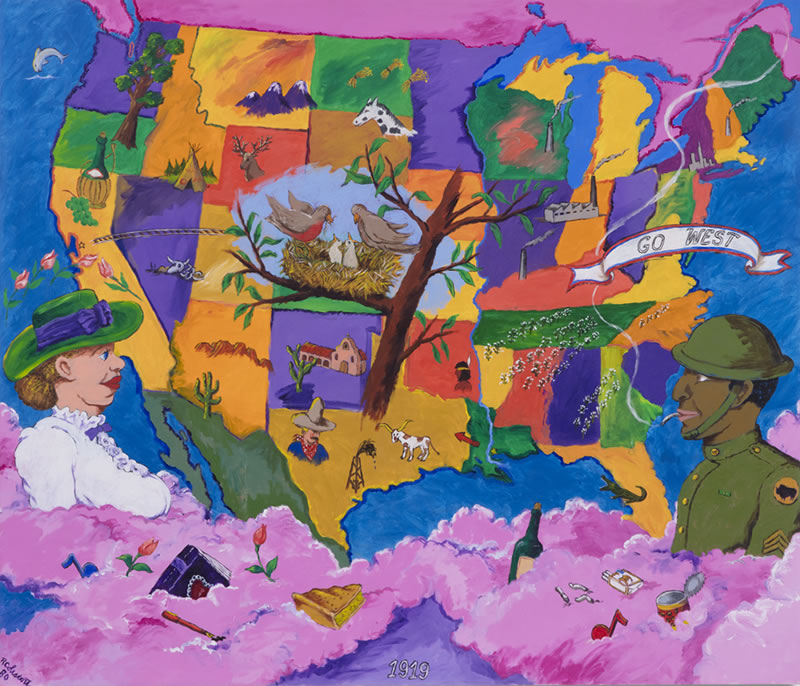Cruel Logic
“ART AND RACE MATTERS: THE CAREER OF
ROBERT COLESCOTT”
NEW MUSEUM
30 JUN – 9 OCT 2022
Published in Spike Art Magazine #73 (Autumn 2022: Vulnerability)
Colored T.V., 1977
Acrylic on canvas, 213 x 168 cm
Acrylic on canvas, 213 x 168 cm
In a political moment where calls for censorship increasingly shudder through America’s right and left flanks, the hottest art on offer is that which offends. Such work is often rescued from the obscurity of its origins in the 1970s, when a handful of unaffiliated artists – alienated by both the cool austerity of Abstract Expressionism and the ironic optimism of Warholian pop – found a third way in the imagery of comic books, caricatures, and the cruel logic of cartoons. This strand of art history is only now taking shape. It began clarifying in the summer of 2020, when the United States was undergoing a reckoning with race, leading to the postponement of a major Philip Guston retrospective thanks to the artist’s cartoonish and self-implicating depictions of Klansmen. Though that exhibition is only now getting underway, the very ambivalence surrounding Guston’s work has unleashed a spate of new shows seeking to air old taboos and edify audiences from their exposure. At the New Museum alone, a series of shows have recently displayed the obscenities of Peter Saul, Faith Ringgold’s race riots and – my favorite so far – the hilarious, libidinal compositions of the late West Coast painter Robert Colescott (1925–2009).
Colescott’s early years – which are passed over too briefly in this retrospective – demonstrate his innate sensitivity to opacity and color, as well as his fascination with perspectival depth as the primary organizational tool of the painter. He was initially an unsatirical admirer of the European masters; early works include respectful homages to John Singer Sargent and Édouard Manet, including a recreation of Manet’s Olympia (1863) that ignores the racially-charged aspect of the subject’s accompanying maid in ways that the later Colescott would never.
In 1964, the artist took a sabbatical to Egypt, where he began painting large, vibrant canvases that are simultaneously figurative and abstract, with faces and limbs melting into a teeming mélange. These “Valley of the Queens” (1964–69) paintings are not his best works, but they are his most ambitious; supposedly inspired by the partially-effaced hieroglyphs still visible on Theban temple walls, they signal a pregnant breakthrough. Three of these paintings share a single wall in the New Museum show – a brief chapter, open and closed.
When the artist returned to the United States, he began making the witty, colorful, and damningly obvious genre works for which he is now known today. Transparent references to Jim Crow-era minstrelsy pockmark Colescott’s satires, which include depictions of Black men as crows or wolves, and Black women as lascivious or as Aunt Jemima. He also began using the greatest hits of art history to provoke and accuse on an elevated plane. Raucous send-ups of Vincent Van Gogh, Pablo Picasso, Willem de Kooning, and Anthony van Dyck smartly call out the white supremacist Eurocentrism of canonical regard, though the older Colescott later confessed his regret at summarized by “paint[ing] the old masters in blackface.”
A change seems to have come around 1980, when Colescott began reinvesting his work with formal ingenuity while continuing with his confrontational themes. Shirley Temple Black and Bill Robinson White (1980) can be appreciated for its painterliness before the sting of its punch line – the two historical entertainers, who danced in films together on several occasions, have switched race. Excised from a scene in Rebecca of Sunnybrook Farm (1938), the painting’s pink sky is imbued with Colescott’s reverence for Fauvism, though it here takes on the added implication that something is off. Robinson’s white face is contorted into a grin that seems neither tortured nor entirely human. It’s a damning portrait of a stereotype that is also subtle and seductive in its displacement, a satire that wins you over before calling you out.

GO WEST, 1980
Acrylic on canvas, 182 x 213 cm
Acrylic on canvas, 182 x 213 cm
The closest Colescott ever got to marrying his depictive condemnations of American hypocrisy with the more transcendent aspects glimpsed in his Egyptian compositions only came towards the end of his life, as his paintings grew denser, more graphic, and more perspectivally complex. His series “Knowledge of the Past Is the Key to the Future,” which he kept up through the late 80s, placed subjects painted in different shades, scales, and styles on the same pictureplane, referencing historical and art-historical characters that are not always easily identifiable. Eventually, these works became as hermetic to the artist’s personal vision as the partially effaced frescos in the Valley of the Queens. As he retreated back into abstraction, vestigial glimpses of figuration still arise – Colescott’s subjects seem to beckon out at us from within their tidal waves of color, bearing their humanity in all of its beauty and ugliness.︎